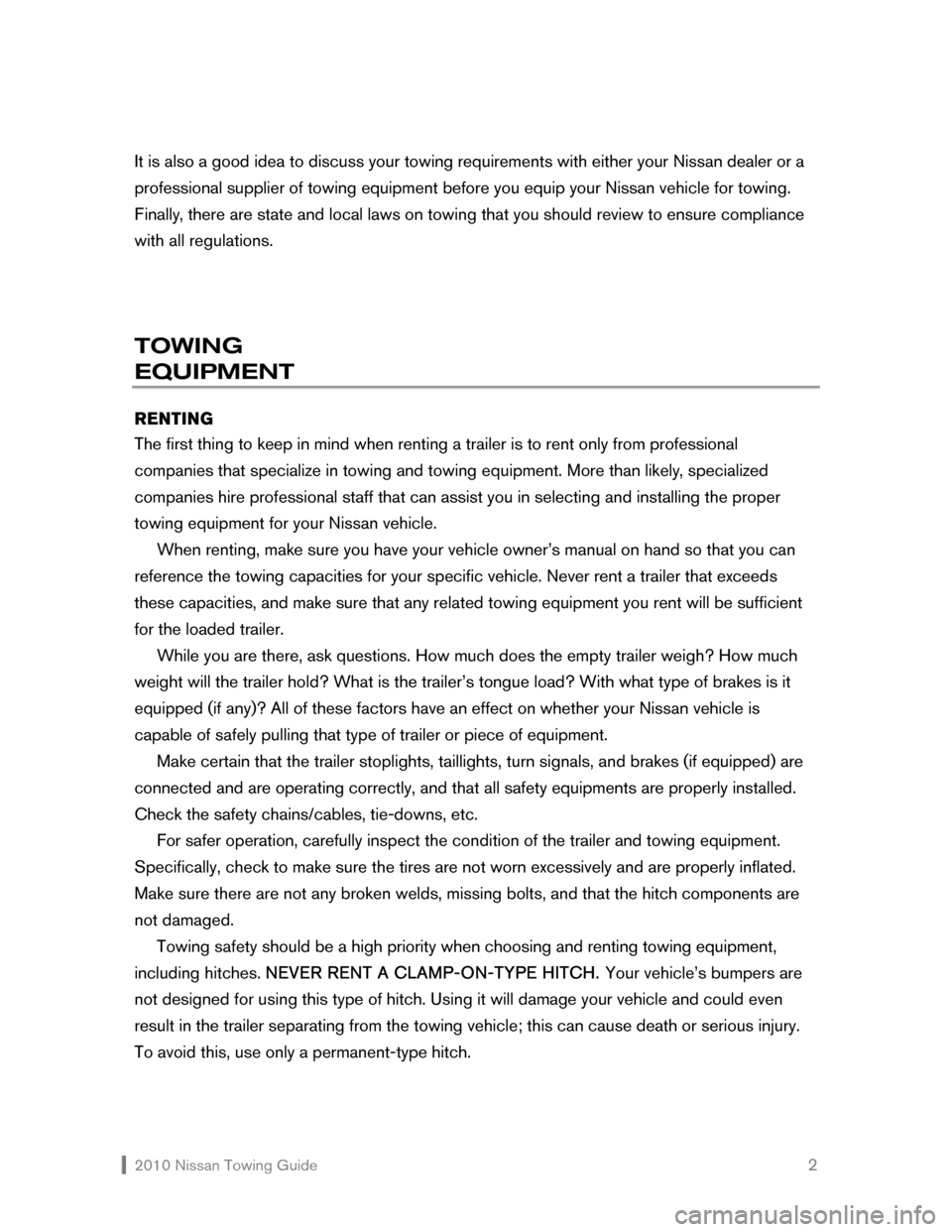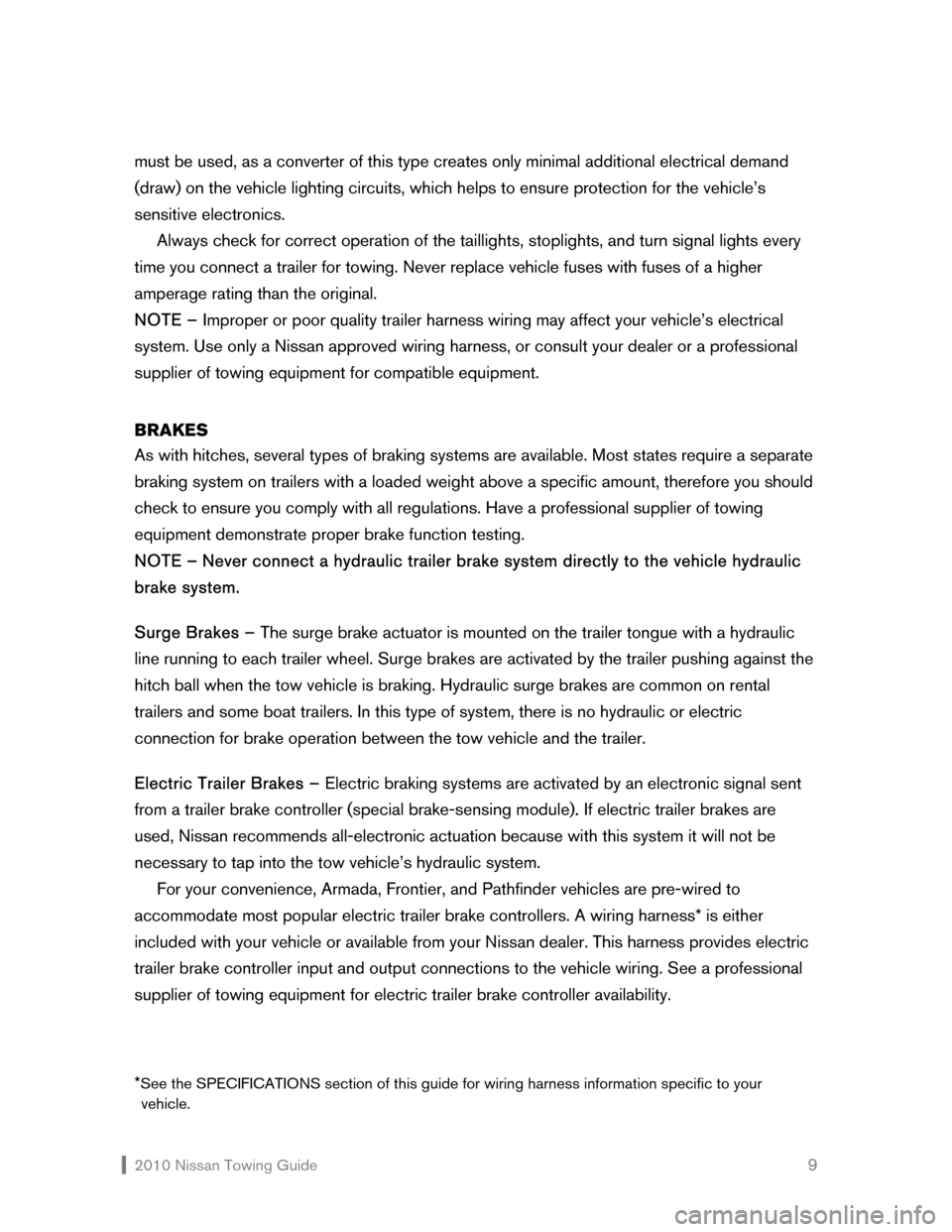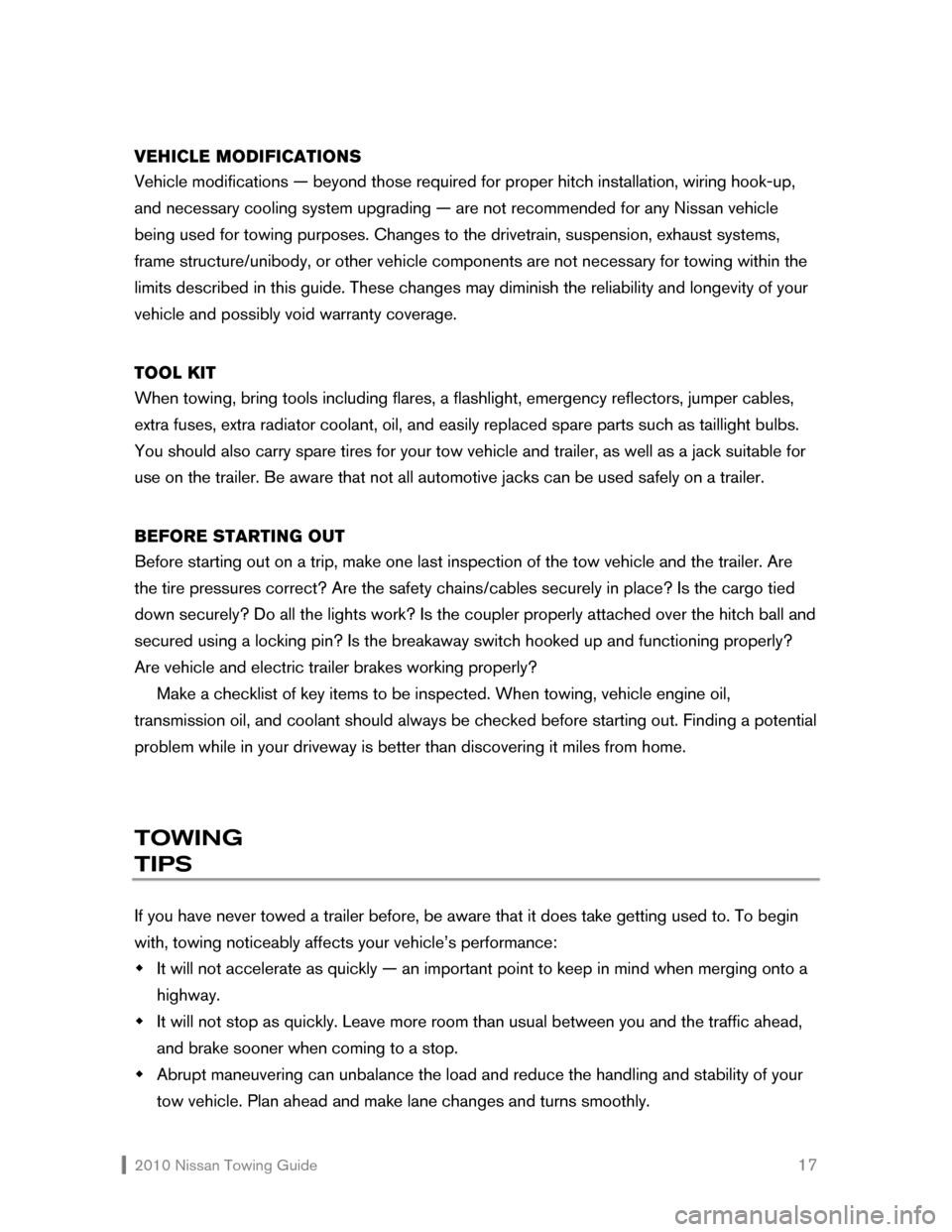lights NISSAN VERSA HATCHBACK 2010 1.G Towing Guide
[x] Cancel search | Manufacturer: NISSAN, Model Year: 2010, Model line: VERSA HATCHBACK, Model: NISSAN VERSA HATCHBACK 2010 1.GPages: 30, PDF Size: 1.01 MB
Page 3 of 30

2010 Nissan Towing Guide 2 It is also a good idea to discuss your towing requirements with either your Nissan dealer or a
professional supplier of towing equipment before you equip your Nissan vehicle for towing.
Finally, there are state and local laws on towing that you should review to ensure compliance
with all regulations.
TOWING
EQUIPMENT
RENTING
The first thing to keep in mind when renting a trailer is to rent only from professional
companies that specialize in towing and towing equipment. More than likely, specialized
companies hire professional staff that can assist you in selecting and installing the proper
towing equipment for your Nissan vehicle.
When renting, make sure you have your vehicle owner’s manual on hand so that you can
reference the towing capacities for your specific vehicle. Never rent a trailer that exceeds
these capacities, and make sure that any related towing equipment you rent will be sufficient
for the loaded trailer.
While you are there, ask questions. How much does the empty trailer weigh? How much
weight will the trailer hold? What is the trailer’s tongue load? With what type of brakes is it
equipped (if any)? All of these factors have an effect on whether your Nissan vehicle is
capable of safely pulling that type of trailer or piece of equipment.
Make certain that the trailer stoplights, taillights, turn signals, and brakes (if equipped) are
connected and are operating correctly, and that all safety equipments are properly installed.
Check the safety chains/cables, tie-downs, etc.
For safer operation, carefully inspect the condition of the trailer and towing equipment.
Specifically, check to make sure the tires are not worn excessively and are properly inflated.
Make sure there are not any broken welds, missing bolts, and that the hitch components are
not damaged.
Towing safety should be a high priority when choosing and renting towing equipment,
including hitches. NEVER RENT A CLAMP-ON-TYPE HITCH. Your vehicle’s bumpers are
not designed for using this type of hitch. Using it will damage your vehicle and could even
result in the trailer separating from the towing vehicle; this can cause death or serious injury.
To avoid this, use only a permanent-type hitch.
Page 9 of 30

2010 Nissan Towing Guide 8 will allow the chains/cables to drag on the ground.
Do not use S-hooks for attaching, as they may become un-hooked and are illegal in many
states. To avoid damage to the bumper and chains/cables when making a sharp turn, do not
attach the chains/cables too close to the coupler. Consult your trailer manufacturer for the
proper location of the chain/cable attachment to the trailer.
REAR VIEW MIRRORS
In many cases, a trailer can block your rear vision when you are using only the standard
Nissan rear view mirrors. These mirrors were not designed for towing. “Extended” mirrors
specifically designed for trailer towing should be used when your rearward vision is
obstructed. Before using these mirrors, make certain that they comply with state and local
regulations. Telescoping Tow Mirrors are available as an accessory for Armada. Contact your
Nissan dealer for details.
BREAKAWAY SWITCH
On a trailer with electric brakes, a breakaway switch can automatically activate the trailer
brake system if the trailer becomes separated from the tow vehicle. Should the trailer become
detached, a breakaway switch may help prevent the trailer from wandering into another lane.
A breakaway switch relies on the power of a trailer battery, so make sure it is not
discharged. Never use the breakaway switch to “park” the trailer on a grade. The battery
would eventually discharge and release the brake, allowing the trailer to roll. Be sure to leave
enough slack in the tether on the breakaway switch to turn corners without binding. If you do
not, the electric trailer brakes will lock-up and not release. See your trailer manufacturer for
proper installation of a breakaway switch that is compatible with your trailer braking system.
TRAILER LIGHTS
Trailer lights should comply with all applicable federal, state, and local regulations, and should
be in proper working order at all times. A trailer’s taillights, stoplights, and turn signal lights
must be wired into the tow vehicle’s electrical system.*
Most trailers operate on a four-wire system in which the stoplights and turn signal lights
utilize the same wire. All Nissan vehicles have separate wires for the stoplights and turn signal
lights, therefore a device called a “converter” is needed.** Specifically, a “powered converter”
*Vehicles equipped with LED taillights require that wiring be connected at a specific location. For
assistance in hooking up trailer lights, contact your Nissan dealer or a professional supplier of towing
equipment.
**Armada, Frontier, and Pathfinder vehicles are pre-wired for trailer lighting and do not require a
converter.
Page 10 of 30

2010 Nissan Towing Guide 9 must be used, as a converter of this type creates only minimal additional electrical demand
(draw) on the vehicle lighting circuits, which helps to ensure protection for the vehicle’s
sensitive electronics.
Always check for correct operation of the taillights, stoplights, and turn signal lights every
time you connect a trailer for towing. Never replace vehicle fuses with fuses of a higher
amperage rating than the original.
NOTE – Improper or poor quality trailer harness wiring may affect your vehicle’s electrical
system. Use only a Nissan approved wiring harness, or consult your dealer or a professional
supplier of towing equipment for compatible equipment.
BRAKES
As with hitches, several types of braking systems are available. Most states require a separate
braking system on trailers with a loaded weight above a specific amount, therefore you should
check to ensure you comply with all regulations. Have a professional supplier of towing
equipment demonstrate proper brake function testing.
NOTE – Never connect a hydraulic trailer brake system directly to the vehicle hydraulic
brake system.
Surge Brakes – The surge brake actuator is mounted on the trailer tongue with a hydraulic
line running to each trailer wheel. Surge brakes are activated by the trailer pushing against the
hitch ball when the tow vehicle is braking. Hydraulic surge brakes are common on rental
trailers and some boat trailers. In this type of system, there is no hydraulic or electric
connection for brake operation between the tow vehicle and the trailer.
Electric Trailer Brakes – Electric braking systems are activated by an electronic signal sent
from a trailer brake controller (special brake-sensing module). If electric trailer brakes are
used, Nissan recommends all-electronic actuation because with this system it will not be
necessary to tap into the tow vehicle’s hydraulic system.
For your convenience, Armada, Frontier, and Pathfinder vehicles are pre-wired to
accommodate most popular electric trailer brake controllers. A wiring harness* is either
included with your vehicle or available from your Nissan dealer. This harness provides electric
trailer brake controller input and output connections to the vehicle wiring. See a professional
supplier of towing equipment for electric trailer brake controller availability.
*See the SPECIFICATIONS section of this guide for wiring harness information specific to your
vehicle.
Page 18 of 30

2010 Nissan Towing Guide 17 VEHICLE MODIFICATIONS
Vehicle modifications — beyond those required for proper hitch installation, wiring hook-up,
and necessary cooling system upgrading — are not recommended for any Nissan vehicle
being used for towing purposes. Changes to the drivetrain, suspension, exhaust systems,
frame structure/unibody, or other vehicle components are not necessary for towing within the
limits described in this guide. These changes may diminish the reliability and longevity of your
vehicle and possibly void warranty coverage.
TOOL KIT
When towing, bring tools including flares, a flashlight, emergency reflectors, jumper cables,
extra fuses, extra radiator coolant, oil, and easily replaced spare parts such as taillight bulbs.
You should also carry spare tires for your tow vehicle and trailer, as well as a jack suitable for
use on the trailer. Be aware that not all automotive jacks can be used safely on a trailer.
BEFORE STARTING OUT
Before starting out on a trip, make one last inspection of the tow vehicle and the trailer. Are
the tire pressures correct? Are the safety chains/cables securely in place? Is the cargo tied
down securely? Do all the lights work? Is the coupler properly attached over the hitch ball and
secured using a locking pin? Is the breakaway switch hooked up and functioning properly?
Are vehicle and electric trailer brakes working properly?
Make a checklist of key items to be inspected. When towing, vehicle engine oil,
transmission oil, and coolant should always be checked before starting out. Finding a potential
problem while in your driveway is better than discovering it miles from home.
TOWING
TIPS
If you have never towed a trailer before, be aware that it does take getting used to. To begin
with, towing noticeably affects your vehicle’s performance:
�Š It will not accelerate as quickly — an important point to keep in mind when merging onto a
highway.
�Š It will not stop as quickly. Leave more room than usual between you and the traffic ahead,
and brake sooner when coming to a stop.
�Š Abrupt maneuvering can unbalance the load and reduce the handling and stability of your
tow vehicle. Plan ahead and make lane changes and turns smoothly.